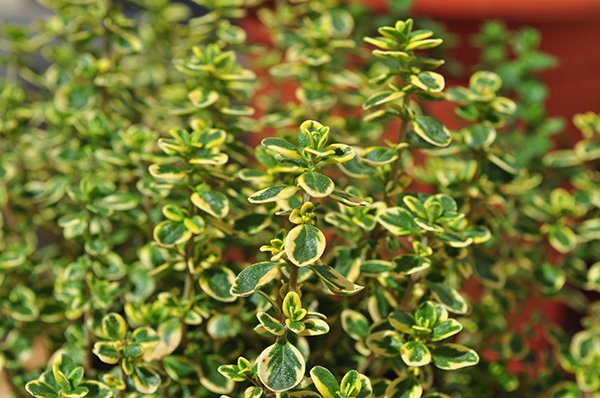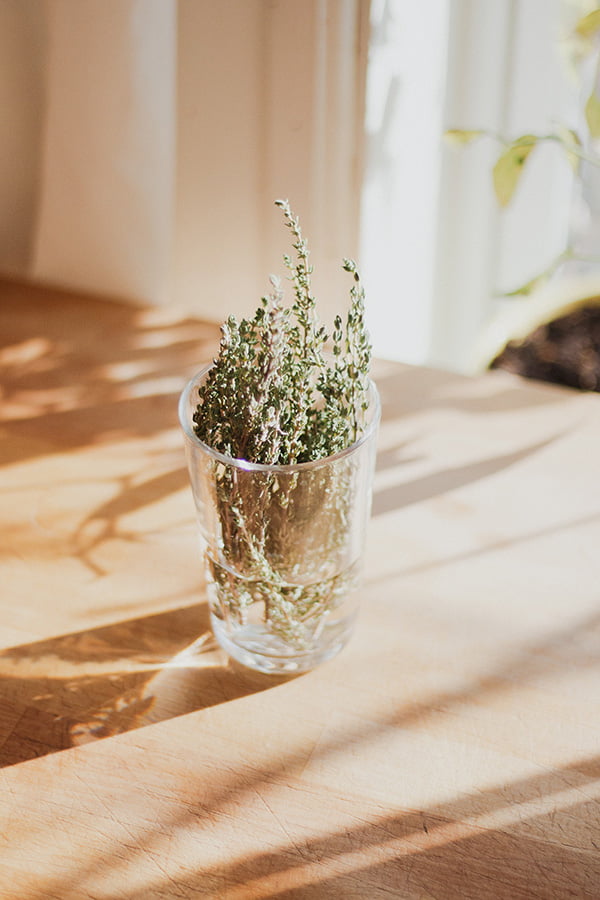Herbs have been a staple in gardens for centuries. They're real powerhouse plants, useful for cooking and medicine. Lemon thyme is a popular culinary herb used in any recipe that calls for lemon, as it has a subtle essence of lemon! Aside from tasting like lemon, lemon thyme plant also smells like lemon, making this herb a great addition to any garden. Growing lemon thyme plants in your garden is easy, and it's incredibly low maintenance with a big pay-off! Below, we'll tell you everything you'll need to know to grow this queen of herbs.
Botanical Name
Common Name
Plant Type
Mature Size
Sun Requirement
Soil Type
Hardiness Zone
Pet Friendly
Thymus citriodorus
Lemon thyme or citrus thyme
Perennial
4" Tall and 24" Wide
Full to part sun
Well drained
6-8S/9W
Yes
What Is Lemon Thyme?
Lemon thyme (Thymus citriodorus) is a particularly citrus-y type of regular thyme. This Mediterranean herb has an earthy, lemony flavor and scent that the plant uses to deter rodents and small mammals from eating it. But it has many other uses as well! It's a flavorful cooking herb in soups, salads, and fish entrees, and it's used in perfumes and cosmetics for its fragrance. Furthermore, its lavender-pink flowers attract a whole host of beneficial insects!
Lemon thyme grows between six to twelve inches tall and twelve to eighteen inches wide. It's compact and can handle being stepped upon from time to time, making it a good choice as a border plant in garden beds or paths. The root system is rather small, so it can grow well in locations with shallow soil, such as a rock garden or retaining wall.
There are many types of lemon thyme cultivars to choose from.
Golden Lemon Thyme has a yellow variegation in its leaves and a less intense citrus scent.
Aureus Lemon Thyme has a distinctive mounding growth pattern.
Golden Dwarf Lemon Thyme, on the other hand, tends to creep along the ground.
Lime Thyme is an interesting cultivar of lemon thyme that has more of a lime flavor than a lemon flavor.
Orange Thyme is another lemon thyme cultivar that tastes more like orange than lemon.

Source: Flickr
Lemon Thyme Care Requirements
Light
Lemon thyme requires full sun, which means at least five hours of direct sunlight daily.
Water
Right after planting your lemon thyme, give it a deep watering twice a week - always check that the top inch or two of the soil is dry first! These spaced-out but thorough waterings will encourage your plant to establish a strong root system. After a few weeks, you can scale it back so that your water once weekly, then every other week, and finally sporadically. It's exceptionally drought-tolerant.
Temperature + Humidity
In USDA Hardiness Zones 5 through 9, lemon thyme grows as a hardy perennial. Thyme is a member of the mint family, so not only will it come back every year, but it will keep its beautiful green sprigs all winter long.
Soil
If you're looking for a plant that will survive in poor soil and thrive, lemon thyme is your plant! As long as it's well-draining soil, it doesn't matter if the soil is rocky or nutrient deficient. If you are growing your lemon thyme in a pot, amend regular potting soil with sand, vermiculite, or perlite, so it drains readily.
Fertilization
Lemon thyme doesn't require any fertilization.
Pruning
It's not necessary to prune lemon thyme, but you can deadhead it after it finishes blooming to encourage another round, or you can use pruning shears to cut it into the shape you'd like. If you live in a zone where lemon thyme grows as an evergreen shrub, you'll notice that the stems at the base of the plant grow woodier as the years go on. You can encourage your thyme to continue producing new growth close to its base through heavy pruning in the fall.
Propagation
Most gardeners choose to start growing thyme by purchasing a small plant from a nursery. You can propagate them from seed, but they are slow to germinate, and it's important to get soil moisture levels perfect during the whole process. It's much easier to propagate lemon thyme through cuttings or plant division.
From Cuttings
In early spring, use clean shears to cut a three-inch length of stem from an established lemon thyme plant.
Remove the leaves from the lower half of the cutting and dip them in powdered rooting hormone.
Fill a small container with well-draining soil and plant the cutting halfway down into the soil. Water it deeply.
Cover the container with a plastic bag to boost humidity. Keep it out of direct sunlight, and check its moisture levels daily.
You'll know you have new roots in four to six weeks by seeing fresh leaf growth! Transplant out into the garden.
From Division
In the spring or fall, dig up the entire root ball of an established lemon thyme plant. Shake off excess soil until the roots are exposed.
Break the plant into three or four sections, untangling the roots carefully.
Replant the mother plant, and transplant the other sections in new locations or pots. Water frequently for a few weeks to help the roots re-establish.

Source: Unsplash
Common Problems With Lemon Thyme
Lemon thyme is a hardy plant, and you likely won't struggle with pests or diseases if planted properly.
Common Pests
Lemon thyme is naturally pest-resistant due to its strong aroma and flavor. However, you still might occasionally see a host of spider mites or aphids. Both of these pests will suck the moisture out of the plant, and you can knock them off with a hard spray of the hose.
Common Diseases
While pests aren't likely to bother your lemon thyme, fungal diseases are more frequent. Root rot is the most prominent, but all fungal diseases are caused by the roots and soil of your lemon thyme being too wet for too long. Remove any affected leaves, allow the soil to grow completely dry, and use stakes to prop stems away from the base of the plant and encourage airflow.
Harvesting Lemon Thyme
Lemon thyme has many uses that cause gardeners to add it to their own gardens. Fresh leaves can be used in many meat, fish and vegetable dishes where they add a subtle essence of citrus flavor. You can add them to fruit salads instead of using lemon juice. Harvesting fresh sprigs is as simple as clipping them from the plant as needed. If your plant is prolific, you can wrap bundles of sprigs with a damp paper towel, place them in a Ziploc bag, and put them in the fridge. This dramatically increases their shelf life, letting you cook with fresh herbs anytime!
However, lemon thyme is a great dried flavoring herb, and it's straightforward to dry a few sprigs. Simply tie a bundle of thin sprigs with string and hang them from a nail in a warm, dark place. They'll be completely dried in a few weeks, and then the dried leaves will come off easily with your fingers. Store dried lemon thyme in a jar in your spice cabinet!
Is Lemon Thyme Pet-Friendly?
Lemon thyme is safe for dogs and most other pets but can cause health issues if ingested by cats. This is because lemon thyme contains phenols that cats cannot metabolize. However, cats have to ingest a very large quantity of lemon thyme for there to be a real concern.
